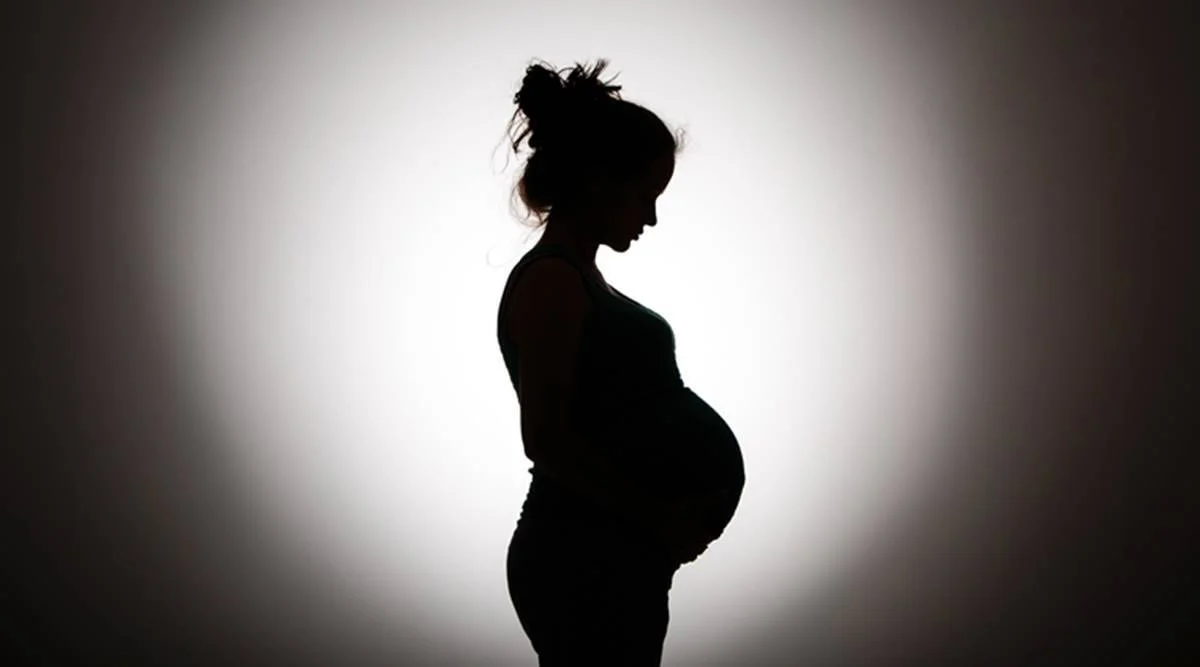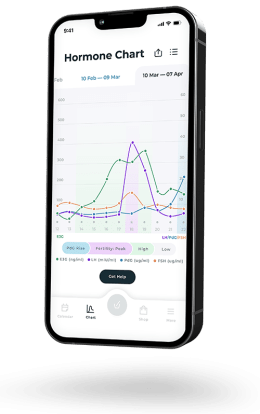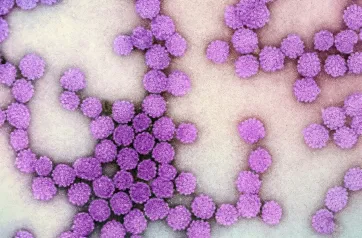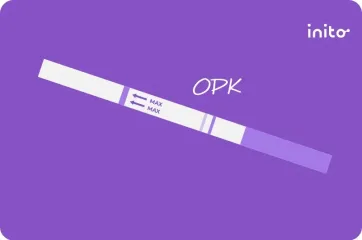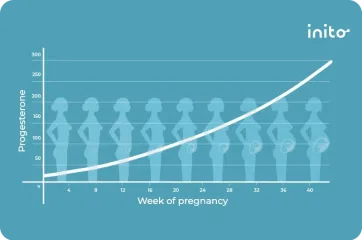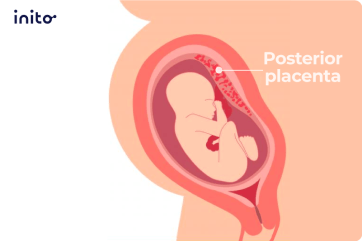Content table
Pregnancy spurs an onslaught of hormonal changes, including a rapid hike in estrogen. And that’s a good thing!
Estrogen plays a key role in maintaining a healthy pregnancy and supporting a baby’s development.
But what are the healthy estrogen levels for pregnancy? And what exactly does this hormone do while you’re pregnant?
Don’t worry – we’re here to answer all those questions and more.
Read on to learn what ‘normal’ estrogen levels in pregnancy look like and why they’re important. We’ll then cover how to check your estrogen levels and what you can do to support estrogen production.
But first, let’s understand how estrogen changes during your cycle.
🤯Takeaways
- Estrogen fluctuates during your menstrual cycle and throughout your lifetime.
- Estrogen supports the development of the placenta and the growth of your baby’s organs. It also primes the body for breastfeeding.
- Estrogen also helps regulate other pregnancy hormones to support fetal development.
- During pregnancy, estrogen levels soar, increasing around sixfold. Estrogen levels can significantly vary during pregnancy and still be in a normal range.
- As the body adjusts to increased estrogen, some symptoms may show up. This includes skin darkening, swollen breasts, nausea, and spider veins.
- Some doctors order quad marker screenings to test estrogen, hCG, Inhibin-A, and Alpha-fetoprotein. This helps identify signs of genetic disorders, such as Down syndrome.
- Shifting your diet may help support estrogen production during pregnancy. Certain foods contain phytoestrogens that mimic estrogen’s actions on the body.
What is the role of estrogen during your menstrual cycle?
Estrogen fluctuates throughout your menstrual cycle. At the beginning of your cycle (the start of your period), estrogen levels are low.
But in the middle of your follicular phase (around 4-5 days before ovulation), estrogen begins rising readily. As it peaks, it prompts the luteinizing hormone (LH) to surge, triggering ovulation.
After an egg is released, estrogen levels levels quickly drop. But not for long. They rise again in your mid-luteal phase, before dipping back down at the end of your cycle.
What is the role of estrogen in pregnancy?
Estrogen is critical for growing a healthy baby. It supports the growth of the placenta, so nutrients can nourish the developing fetus.
It also stimulates the growth of your baby’s organs, including the lungs, liver, and adrenal glands. Estrogen even triggers your baby’s adrenal glands to kickstart hormone production!
Estrogen is equally important for pregnant women.
Estrogen helps maintain the uterine lining and helps the uterus grow to make space for your growing baby. It enlarges the milk ducts in the breast tissue to prime your body for breastfeeding.
However, estrogen also influences other pregnancy hormones as well.
For example, estrogen levels tend to affect on progesterone production. Estrogen helps in pushing the production of LH to trigger ovulation. The ruptured follicle forms the corpus luteum which releases progesterone.
Progesterone helps keep the uterine lining thick and prevents uterine contractions. So, it’s crucial for maintaining pregnancy and preventing a miscarriage.
High estrogen levels also keep Follicle-Stimulating Hormone (FSH) and LH in check. This keeps your body from getting your period while you’re pregnant.
Estrogen even enhances your sensitivity to oxytocin, another important pregnancy hormone that helps in uterine contractions and labor.
Here are some numbers to paint a picture of how estrogen changes in your blood throughout the month:

See how your hormone chart might look like!
Answer some questions to help us provide you a free personalized hormone chart customized to your hormonal health and conditions
Estrogen levels during the menstrual cycle
Early follicular phase | Late follicular phase | Luteal phase |
30-100 pg/mL | 10-100 pg/mL | 60-150 pg/mL |
As you can see, there’s a lot of wiggle room for what’s ‘normal’ estrogen level during your cycle.
Estrogen is typically measured in picograms per milliliter (pg/mL). One picogram equals one trillionth of a gram, which shows that a little estrogen can go a long way!
Estrogen levels also significantly vary throughout your lifetime.
After menopause, estrogen takes a nosedive. Postmenopausal estrogen levels are usually below 18 pg/mL. This is because after ‘the change’ your ovaries stop making estrogen.
But during pregnancy, estrogen does just the opposite…
What’s a normal estrogen level during pregnancy?
Your body’s estrogen levels skyrocket while pregnant. Yet the primary form of estrogen also shifts.
Estradiol (E2) is the main form of estrogen for women in their reproductive years. But estriol (E3) is the main estrogen produced during pregnancy.
The corpus luteum supplies most of your body’s estrogen in early pregnancy. But once the placenta forms, it takes charge of estrogen production. This typically happens by the end of the first trimester (week 12).
So, what’s a ‘good’ estrogen level for pregnancy?
That’s tough to say. Estrogen can be all over the map during pregnancy and still remain in a healthy range. Your estrogen levels at 4 weeks pregnant will look dramatically different at 34 weeks.
The main thing to know is that estrogen is much, much higher while pregnant. In fact, it increases roughly sixfold before peaking in the third trimester (around week 32).
The chart below will give you a rough idea of what to expect…
Estrogen levels in blood during pregnancy week by week:
First trimester | Second trimester | Third trimester |
188 – 2,497 pg/mL | 1,278 – 7,192 pg/mL | 3,460 – 6,137 pg/mL |
Symptoms of estrogen in pregnancy
During the first trimester, a roller coaster of hormonal changes happens. As your body adjusts to these changes, you may notice some symptoms.
Swollen breasts
As mentioned, estrogen enlarges the milk ducts, prepping your breasts for milk production. So, as estrogen climbs in pregnancy, your bra size may do the same. Your breasts may feel more tender or sensitive as well.
Hyperpigmentation
Around 90% of women experience some type of skin darkening during pregnancy. During pregnancy. This is known as hyperpigmentation. So if your nipples, armpits, or genitals are looking a bit darker, you have estrogen to thank.
One way hyperpigmentation can show up is melasma. Also known as the ‘mask of pregnancy,’ this is when dark patches of skin pop up on the face. It happens for around 70% of pregnant women.
For most women, melasma and other hyperpigmentation go away within a few months of giving birth.
Skin changes
Hyperpigmentation isn’t the only skin change estrogen triggers. As estrogen rises, it increases circulation to your skin.
For some women, this may lead to patches of red, blotchy skin. But for others, this may show up as a ‘pregnancy glow.’
Spider veins
As blood flow increases during pregnancy, it puts extra pressure on your blood vessels. For some women, this may cause spider veins.
While these purple, threadlike veins can be a nuisance, they’re harmless. Usually, they fade a few months after childbirth as your blood flow returns to normal.
Swollen ankles, legs, and feet
Yep, you can blame your puffy feet on estrogen too. Estrogen causes your body to retain water.
So as estrogen rises during pregnancy, fluid can build up in your tissues. This may lead to swollen ankles, feet, and legs. Often this gets worse later in the day and further into pregnancy.
Ironically, drinking plenty of water can help ease this symptom. Resting with your feet up, taking regular walks, and avoiding standing for long periods may also reduce swelling.
Nausea
During the first trimester, nausea and vomiting (aka ‘morning sickness’) are quite common.
In fact, around 70-80% of pregnant women experience morning sickness. While it’s unclear what causes it, some believe high estrogen levels or rising progesterone and hCG (human chorionic gonadotropin) may play a role.
Testing for estrogen
If you’re pregnant and want a look at your estrogen levels, your doctor may advise a blood test.
Quad marker screenings are one way to do this. This blood test is commonly done during the second trimester, between the 16th and 18th weeks of pregnancy.
As the name suggests, quad markers test for four things:
- Estriol (E3): the main form of estrogen during pregnancy
- Human chorionic gonadotropin hormone (hCG): a pregnancy hormone made by the placenta
- Inhibin-A: a hormone made by granulosa cells in the ovary
- Alpha-fetoprotein (AFP): a protein made by the fetus’ liver
This data can help identify if the fetus has any signs of a genetic disorder such as Down Syndrome. Quad tests are typically optional. But they’re often recommended for women who:
- Are age 35 or older
- Have a family history of birth defects
- Are diabetic and take insulin
- Had a viral infection while pregnant
- Took harmful drugs or medications during pregnancy
Doctors can also check your estrogen levels using urine or saliva tests. In addition, some tests allow you to check your estrogen from home. More on that in the next section…
Low estrogen during pregnancy
Low estrogen can make it difficult to get pregnant and increase the risk of miscarriage. This is especially true for those undergoing IVF treatment.
Estrogen is part of the hormonal cocktail doctors prescribe during IVF. It stimulates egg growth and helps thicken the uterine lining to prep the womb for pregnancy.
One study found that women with higher estrogen levels on day 4 of IVF had higher pregnancy rates and delivery rates.
Once pregnant, low estrogen isn’t all that common. Remember, the range for ‘normal’ estrogen levels during pregnancy is quite wide.
Having unusually low estrogen while pregnant doesn’t tell you much on its own. But if it’s coupled with other hormonal issues, it can increase the risk of preeclampsia.
This is a serious condition that causes high blood pressure during pregnancy. It typically happens midway through pregnancy (after the 20th week).
If preeclampsia is not treated, it can lead to serious complications for both mother and baby.
Keep in mind that estrogen levels ebb and flow throughout pregnancy. So if a single test shows your estrogen is low, try not to stress. Your levels could look completely different the next day.
How to support estrogen production during pregnancy?
You can support estrogen production during pregnancy by making some simple tweaks to your diet.
Certain foods contain phytoestrogens, also called dietary estrogens. These plant compounds attach to estrogen receptors, mimicking estrogen’s effects on the body.
Eating more foods with phytoestrogens may help your body maintain the estrogen levels needed for pregnancy.
Foods that are rich sources of phytoestrogens include:
- Soy foods, such as edamame and tofu are rich in isoflavones
- Dried fruit, including dried apricots, dates, and prunes are high in isoflavones and lignans
- Seeds, particularly flaxseed and sesame seeds are high in lignans
- Legumes, especially kidney beans, chickpeas, and lentils are also rich in isoflavones
Because progesterone is equally important for pregnancy, you may also want to include progesterone-boosting foods as well. Check out this post for a complete breakdown.
Learn more about how to increase progesterone.
Was this article helpful?
- The Normal Menstrual Cycle and the Control of Ovulation – Endotext – NCBI Bookshelf
- Reference Values For Estradiol in Pregnancy
- Estrogen regulation of placental angiogenesis and fetal ovarian development during primate pregnancy – PMC
- Estrogen Maintains Pregnancy, Triggers Fetal Maturation — ScienceDaily
- Gene expression of estrogen and oxytocin receptors in the uterus of pregnant and parturient bitches – PMC
- Steroid hormone levels in pregnancy and 1 year postpartum using isotope dilution tandem mass spectrometry – PMC
- Dermatologic conditions in patients of color who are pregnant – PMC
- Estrogen influences osmotic secretion of AVP and body water balance in postmenopausal women
- Nausea and Vomiting of Pregnancy – PMC
- Prediction of miscarriage in first trimester by serum estradiol, progesterone and β-human chorionic gonadotropin within 9 weeks of gestation | BMC Pregnancy and Childbirth
- Day 4 Estradiol Levels Predict Pregnancy Success in Women Undergoing Controlled Ovarian Hyperstimulation for IVF – Fertility and Sterility
- Estrogen and Preeclampsia: Potential of Estrogens as Therapeutic Agents in Preeclampsia – PMC
- Phytoestrogens and Their Health Effect – PMC
- Naturally occurring oestrogens in food




